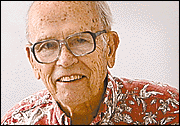Advertisement - Click to support our sponsors.


Hawaii’s World
THE term "outsider" sometimes stirs negative connotations. But North Hawaii has benefited immensely from two of them. Outsiders who
made a differenceThe first was Laurance Rockefeller of New York City, who wanted to use his great wealth in a way that would give him a profit but also spur job development in depressed areas.
To this end he built resort luxury hotels in Puerto Rico and the Virgin Islands -- not in their Waikiki counterparts but in remote places where jobs were badly needed.
He turned his focus to Hawaii around the time of statehood. He communicated his idea to then-Gov. William Quinn. The governor and his economic development director, George Mason, arranged to fly Rockefeller along the coasts of all the islands to look for sites.
The site Rockefeller spotted was an idyllic beach in North Hawaii, over 25 miles from the major tourist center at Kailua-Kona, in an area where sugar mechanization had created high joblessness.
The Mauna Kea Hotel stands there today. It since then has spurred building of other luxury hotels on the Kona-Kohala coast. For Rockefeller, the Mauna Kea was a loss leader that allowed him to convert its surrounding acres into posh residential sites -- and earn an overall profit.
Enter now Earl T. Bakken, a Minnesotan who in 1957 invented the first wearable heart pacemaker and started down a road to riches that eventually made him decide to relocate to a less chilly climate. A tourist visit to remote, quiet Kona Village led him to build a home in Kona. His intention: quiet retirement.
The medical needs of North Hawaii, which had only a clinic in Waimea, were immense. Community leaders spotted the humanitarian streak in Bakken and persuaded him to pitch in to build a first-rate, fully equipped acute-care hospital close by the clinic.
North Hawaii Community Hospital -- opened in 1996 -- is a marvel in many ways. Patient rooms are bigger than in any major Honolulu hospital, all single, all with doors to gardens through which pets, even a beloved ranch horse, could come to visit. North Hawaii babies now can be born with an obstetrician on hand instead of just a midwife.
Halls are wide to reduce stress. Skylights bring in maximum daylight. Equipment includes the latest in high tech.
But that's not enough. High tech is humanized with access also to naturopathy, chiropractic, acupuncture, massage therapy and clinical psychology. An annex called Tutu's Center is in the Parker Ranch Shopping Center. There even computer ignoramuses like me can look into computer files for health information with the help of teen-age volunteers.
Bakken thinks managed care, as with HMOs, has peaked. He thinks informed personal care choices funded from IRA-like Medical Savings Accounts will be the wave of the future.
He sees the hospital as a health and job-creation center for a part of our "health state" with one of its poorest health records. But he has a wider view of North Hawaii becoming also a health center for the ailing rich of the world where they might use the hospital, plus spas at just about all the major Kona-Kohala and Hilo hotels in their recoveries.
He thinks a special ancient Hawaiian healing energy can be claimed for the area drawn from its surrounding active and inactive volcanoes.
Five Mountain Medical Community is the name tabbed on the total area including the hospital, Tutu's Center and the hotel health spas.
Rockefeller ultimately made money on his investment. Bakken's reward is most apt to be in personal satisfaction.
A.A. Smyser is the contributing editor
and former editor of the the Star-Bulletin
His column runs Tuesday and Thursday.